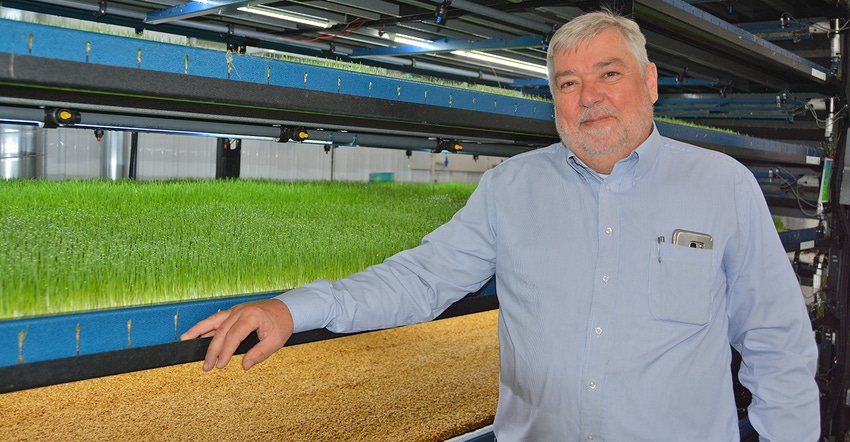May 15, 2017

Need more affordable feed?
Almost everyone with livestock would probably answer “yes” to that question at one time or another.
A drought may cut your hay and corn silage yields.
Feed prices may get too high relative to the livestock market.
You might not be able to find more land in your area to rent or buy to grow more feed, or the price to buy or rent land may be too high.
The answer to all these situations is “land on a stand,” says Dihl Grohs, a Wessington Springs, S.D., cattleman and inventor and CEO of HydroGreen Global Technologies. He developed a way to automate hydroponic sprouted barley fodder production year-round inside a climate-controlled building.
Grohs has such a system operating on a farm at Renner, S.D. The $290,000 setup, which includes the building and two growing systems with six growing decks, is producing the same amount of feed in a year as about 300 acres of corn silage, says Craig Livingston, HydroGreen president.
Land in the Renner area, which is just outside of Sioux Falls, sold at auction for as much as $9,600 per acre this spring. That would be about $2.8 million for 300 acres, or $2.5 million more than the HydroGreen building and equipment. Plus no tractor, planter or forage chopper is needed to produce sprouted barley fodder.
Hydrogreen growing systems (not including a building) start as low as $20,000.
“If you are interested in more affordable feed, this is a no-brainer,” Grohs says.
Feed uses
A HydroGreen system would be an exceptional investment for all livestock producers, he says, but especially for beginning farmers with limited land or grain growers who could bale stover and feed cattle in a hoop barn or drylot. You could mix the HydroGreen fodder and stover together for an extremely low-cost ration.
“You could feed thousands of head this way and make money,” he says.
Grohs supplemented his own beef cows and calves with sprouted barley while they were out on pasture near Wessington Springs and was able to boost the stocking rate 40%. He’s feeding sprouted barley produced at Renner to his cattle, which are in a nearby finishing feedlot. It is replacing distillers grains in the ration.
Richard Weaver, also from Wessington Springs and a lifelong friend of Grohs, says feeding fodder improved the health of his cows and calves so much it eliminated vet bills. It also cut his feed cost by at least a third and increased weaning weights of his Charolais-cross beef calves by 50 pounds. Weaver is putting up a new HydroGreen facility on his ranch this year.
“The stuff is almost magical,” he says.
Dairymen could benefit by feeding milk cows live green grass year-round, Livingston says. In university tests paid for by HydroGreen, the sprouted barley did not affect the taste of the milk.
Sprouted barley and other grains can also be fed to sheep, goats, pigs, poultry and other farm animals.
What’s sprouted fodder?
Feeding sprouted fodder isn’t common in the Midwest, but it is fed extensively in other parts of the world. However, up until now, production involved seeding and harvesting the sprouted grains by hand. Inspired by robotic milkers, Grohs and his team figured out how to completely automate production. They have 38 patents pending on the project.
“You go from seeding to harvesting in six days, and you never have to touch it,” Livingston says. “All you do is push buttons on the control panel.”
HydroGreen fodder qualifies as an organic feed. It is chemical-free. No fertilizer or pesticides are used. It’s non-GMO. A HydroGreen system uses 93% to 98% less water to produce sprouted barley than is needed to produce the same amount of corn silage or hay.
“It’s the future of feed,” Grohs says.
For more information, contact HydroGreen at 605-277-7271 or see livegreenfeed.com.
You May Also Like




